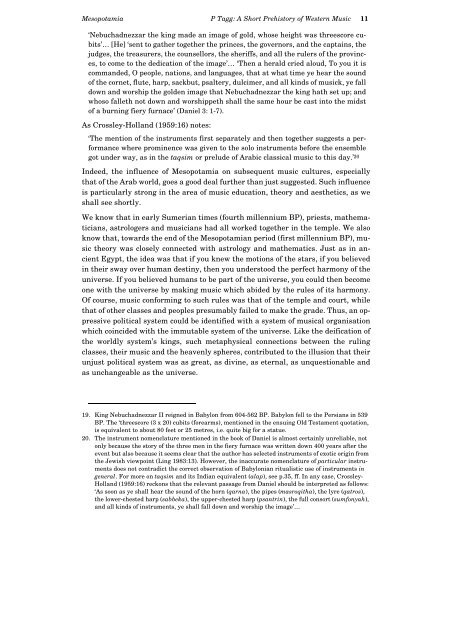A Short Prehistory of Western Music, Chapter 3
A Short Prehistory of Western Music, Chapter 3
A Short Prehistory of Western Music, Chapter 3
You also want an ePaper? Increase the reach of your titles
YUMPU automatically turns print PDFs into web optimized ePapers that Google loves.
Mesopotamia P Tagg: A <strong>Short</strong> <strong>Prehistory</strong> <strong>of</strong> <strong>Western</strong> <strong>Music</strong> 11<br />
‘Nebuchadnezzar the king made an image <strong>of</strong> gold, whose height was threescore cubits’…<br />
[He] ‘sent to gather together the princes, the governors, and the captains, the<br />
judges, the treasurers, the counsellors, the sheriffs, and all the rulers <strong>of</strong> the provinces,<br />
to come to the dedication <strong>of</strong> the image’… ‘Then a herald cried aloud, To you it is<br />
commanded, O people, nations, and languages, that at what time ye hear the sound<br />
<strong>of</strong> the cornet, flute, harp, sackbut, psaltery, dulcimer, and all kinds <strong>of</strong> musick, ye fall<br />
down and worship the golden image that Nebuchadnezzar the king hath set up; and<br />
whoso falleth not down and worshippeth shall the same hour be cast into the midst<br />
<strong>of</strong> a burning fiery furnace’ (Daniel 3: 1-7).<br />
As Crossley-Holland (1959:16) notes:<br />
‘The mention <strong>of</strong> the instruments first separately and then together suggests a performance<br />
where prominence was given to the solo instruments before the ensemble<br />
got under way, as in the taqsim or prelude <strong>of</strong> Arabic classical music to this day.’ 20<br />
Indeed, the influence <strong>of</strong> Mesopotamia on subsequent music cultures, especially<br />
that <strong>of</strong> the Arab world, goes a good deal further than just suggested. Such influence<br />
is particularly strong in the area <strong>of</strong> music education, theory and aesthetics, as we<br />
shall see shortly.<br />
We know that in early Sumerian times (fourth millennium BP), priests, mathematicians,<br />
astrologers and musicians had all worked together in the temple. We also<br />
know that, towards the end <strong>of</strong> the Mesopotamian period (first millennium BP), music<br />
theory was closely connected with astrology and mathematics. Just as in ancient<br />
Egypt, the idea was that if you knew the motions <strong>of</strong> the stars, if you believed<br />
in their sway over human destiny, then you understood the perfect harmony <strong>of</strong> the<br />
universe. If you believed humans to be part <strong>of</strong> the universe, you could then become<br />
one with the universe by making music which abided by the rules <strong>of</strong> its harmony.<br />
Of course, music conforming to such rules was that <strong>of</strong> the temple and court, while<br />
that <strong>of</strong> other classes and peoples presumably failed to make the grade. Thus, an oppressive<br />
political system could be identified with a system <strong>of</strong> musical organisation<br />
which coincided with the immutable system <strong>of</strong> the universe. Like the deification <strong>of</strong><br />
the worldly system’s kings, such metaphysical connections between the ruling<br />
classes, their music and the heavenly spheres, contributed to the illusion that their<br />
unjust political system was as great, as divine, as eternal, as unquestionable and<br />
as unchangeable as the universe.<br />
19. King Nebuchadnezzar II reigned in Babylon from 604-562 BP. Babylon fell to the Persians in 539<br />
BP. The ‘threescore (3 x 20) cubits (forearms), mentioned in the ensuing Old Testament quotation,<br />
is equivalent to about 80 feet or 25 metres, i.e. quite big for a statue.<br />
20. The instrument nomenclature mentioned in the book <strong>of</strong> Daniel is almost certainly unreliable, not<br />
only because the story <strong>of</strong> the three men in the fiery furnace was written down 400 years after the<br />
event but also because it seems clear that the author has selected instruments <strong>of</strong> exotic origin from<br />
the Jewish viewpoint (Ling 1983:13). However, the inaccurate nomenclature <strong>of</strong> particular instruments<br />
does not contradict the correct observation <strong>of</strong> Babylonian ritualistic use <strong>of</strong> instruments in<br />
general. For more on taqsim and its Indian equivalent (alap), see p.35, ff. In any case, Crossley-<br />
Holland (1959:16) reckons that the relevant passage from Daniel should be interpreted as follows:<br />
‘As soon as ye shall hear the sound <strong>of</strong> the horn (qarna), the pipes (masroqitha), the lyre (qatros),<br />
the lower-chested harp (sabbeka), the upper-chested harp (psantrin), the full consort (sumfonyah),<br />
and all kinds <strong>of</strong> instruments, ye shall fall down and worship the image’…














